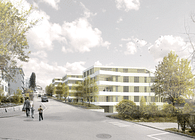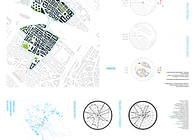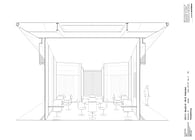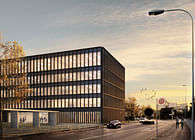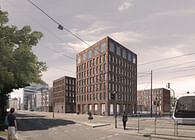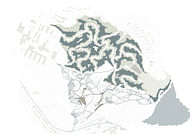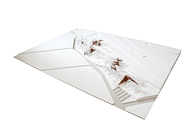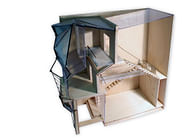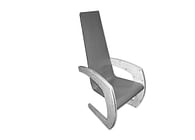
INITIAL RESEARCH & MACRO STRATEGY
The South Wales Valleys poignantly demonstrate the cumulative effects of careless political power on a resource-rich land, through the remnants of its coal industry, fragmentation of social structure, and mass unemployment. Transformation into a post-industrial landscape has left pockets of settlements, each with their own identity, yet disconnected, unsupported and with few common objectives for their future. Political strategies have attempted to fragment the county boundaries in
order to delegate efforts to each, yet this has in fact counteracted their objective. As a response, the group research established three macro strategies:
HEADS OF VALLEY COUNTY
-re-define and consolidate the complex county boundary relationships through three cantons and
seven communes, whilst maintaining the identities which are intrinsic to each settlement.
NODAL TOWNS
-recognising the constructive hierarchy of towns across the defined region, encouraging natural
local migration and support for both growth and decline.
PHYSICAL & VIRTUAL CONNECTIVITY
-improved transportation and digital infrastructure to enforce town hierarchies and the potential for
future wide-region support.
Further individual research focuses on virtual connectivity as a means of defragmenting and supporting the wider region through a digital network that would not negate the physical identity intrinsic to each settlement.
OVERVIEW
Today’s ‘Information Age’ has become, to the majority of us, commonplace; it is an age of ubiquitous information and thriving virtual communities. These often ephemeral virtual worlds of blogs, social networking and open-source material are places of rapid development with collective goals, places that demonstrates a symbiosis between the individual and the many where everyone can have their say and are comfortable in doing so. However inspiring and successful these virtual worlds may be, the ontological consequences of such experiences if they remain in the virtual ‘bitsphere’ is of concern; they have yet to find appropriate manifestation into material reality other than through the common computer screen.1 I believe that architecture can play a crucial role in advocating a more appropriate mediation into material reality through dismissing the dystopian prospect of a total ‘bitspherian’ experience of life.
The region is currently one of the most digitally deprived areas of the UK. However, the Welsh Assembly Government have recently focused efforts and funding for its ‘Delivering a Digital Wales’ agenda which would contribute to the essential digital infrastructure required for the strategy. Further potential arises from their sub-programme ‘Communities 2.0’ (a joint partnership already benefiting from an ERDF funded £19.9m budget) as a means of harnessing virtual technology to aid business enterprises and individuals, encouraging employment opportunities throughout Wales. The potential of collective ‘cloud computing’ offers both a conceptual analogy of the historical industry intrinsic to the area, and a means of reversing its structural hierarchy into a more democratised,
bottom-up model that would shed positive light on the Valleys much as coal and iron did in their thriving industrial age. Thus the ‘Community 2.0’ programme presents a clear call and potential client for developing the thesis.
SITE
As one of the key nodal towns outlined in the initial research, Merthyr Tydfil’s town centre was chosen as the location on account of its geographical, historical and political significance. The tightly constrained brown field site rests at the intersection between the current council offices and the former congregational, now derelict town hall, providing a challenging yet opportune location for the thesis’s architectural exploration.
‘THE FORUM’ - PROGRAMME RESOLUTION
The collective mind-set envisaged in the programme would consolidate the complex administrative boundaries that now constitute the Valleys. However, these somewhat haphazard virtual worlds evidently need some governance. The physical manifestation of architecture offers a paradigm for control, as demonstrated through Berlin’s Reichstag, yet - through the mediation of digital technologies - can remain democratised. Initial research speculated on harnessing Augmented Reality (AR) technology as a means of supporting this democratised and flexible future for the proposed Heads of Valleys County, as well as exploring a material intersection between physical
and digital realities. This might have manifested as projections onto existing structures across the region. which would display the efforts of collective goals over the network. However, it negated the potential of material architecture and presented a contradiction to the initial argument, hence limiting the exploratory scope for the thesis. Rather than a continued expansion of the ‘bitsphere’, Community 2.0 and the Welsh Assembly Government are in need of a more focused hub - an archetypal testing ground from which to evolve.
Thus, as a vehicle to steer the thesis, a ‘Community 2.0 Forum’ (digital government, learning and research centre) could find more appropriate architectural expression. As part of the extended Welsh Assembly Government, the primary intention is for the centre to govern and utilize the vast digital network that the Heads of Valley County could accommodate. Ultimately, this would provide agency for the evolution of Communities 2.0. However it should be stressed that to govern is meant here in the broadest sense of the word and emphasis is placed on advocating a digital democracy . This political transparency therefore translates into the architectural language and programme.
GOVERN
To avoid a purely centralised and bureaucratic institution, the forum is heavily dependent on two-way feedback loops between its assembly members and the surrounding community. It is also the space in which the relationship between physical and virtual realities is most harmonious. The initial research into Augmented Reality is therefore reintroduced as a means of mediating this relationship through ‘virtual debates’.
LEARN
This public interaction is evidently key to supporting such a democratic model, however it is heavily dependent on the experiences within the virtual ‘bitsphere’. Interactive exhibition spaces therefore serve to attract, inspire and demonstrate the possibilities of emergent technologies in the physical realm. Additionally, ‘virtual classrooms’ and an auditorium ensure inclusive learning and development for the region does not remain in the dystopian ‘bitsphere’.
RESEARCH
In spirit of the ephemeral ‘bitsphere’s’ rapid development of open-source material, and symbiosis between the individual and collective, research spaces focus on ensuring an evolution of the prototypal Community 2.0 Forum. Ultimately, this would redeem a prosperous reputation for the South Wales Valleys.
ARCHITECTURAL (MICRO) STRATEGIES
A series of architectural strategies and analogies are placed in order to explore the representation of the thesis question and organisation of programme - a glossary of which is provided below:
NETWORK LAY LINES
–representing the wider network of nodal towns, they provide the horizontal separation of programme and circulation routes; ensuring a perpetual connection to the peripheral reality.
VERTICAL PROGRESSION
–from the collective to the individual. The intersection of the lay lines becomes a central crux
and thus location for the forum to filter the rain of digital information through the architecture’s
programme.
PUBLIC / PRIVATE DOMAINS
–private requirements are negotiated through the occupation of specific vertical domains (shifted
through half public domain levels in either vertical direction.) This places further emphasis on a
democratic model through moments of interaction between both.
GRIDED VOLUMETRIC ORGANISATION
–focuses on the spatial experience of the physical realm, and articulates as a series of identifiable nodes suspended within the digital realm.
ENVIRONMENTAL ‘DIGITAL’ SHELL
-as both a material juxtaposition to the above and environmental control, the translucent ‘digital’
shell encapsulates the physical volumes and expresses a dialogue between both.
MATERIAL EXPRESSION OF USE
-concrete = permanence / physical
-’lightstone’ = intersection / network activity
-steel, glass, OLED, AR = flexible / digital
-timber = inhabitation
1 Mitchell, William J., City of Bits : Space, Place, and the Infobahn (Cambridge, Mass: MIT Press, 1995), pp. vii , 225 p
Status: School Project
Location: Merthyr Tydfil, GB

